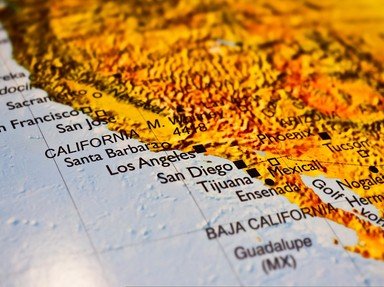Quiz Answer Key and Fun Facts
1. Let's start off in North America. This large river begins at the outflow of Lake Ontario and is part of the international boundary between Canada and the USA.
2. Still on the North American continent, we travel south-west to the USA/Mexico border, where a large river forms a natural boundary between these two countries. The entire US side of the border formed by this river is the territory of the state of Texas.
3. South-east we go! The Artibonite River is a rare instance of a river forming an international state border...on an island. Given that we are in the Caribbean Region, name the ISLAND in question.
4. We're in South America now, in the landlocked country of Paraguay - pretty much close to the centre of the continent if you take a look at the map. There are two main large rivers that form this country's borderline BOTH with Brazil and Argentina - two largest countries (by area). One is the Paraguay River and the other is a river to which the Paraguay River is a tributary! Name that river.
5. In Buenos Aires we board a ship heading east towards Africa. The ship touches shore just south of the Equator, near a place where a certain river flows into the Atlantic Ocean. A significant section of that river forms a boundary between two nations who have a common name (well, a part of the name, to be exact). And what is even more interesting is that name is also the name of the river I'm asking you to name. What is it?
6. Still feeling exhausted by the Transatlantic cruise, we board a plane that takes us quickly to Europe. The plane lands in the capital of a landlocked country, a beautiful city which lies on a major European river that flows along six (yes, SIX!) international borders, ending its course in the Black Sea. I'm obviously talking about which river?
7. We don't have to travel far away to see the river mouth of another great river which also flows into the Black Sea. Its importance is valued by the two countries that share a border along this river - Ukraine and Moldova, but also for a self-proclaimed republic of Transnistria which is recognized only by several independent states.
8. Eastern Europe opens a possibility of travel further to the east, which takes us to Asia. This one shouldn't be too difficult: name a river that rises in the western Himalayas, flows through such important cities of India as Varanasi and Patna and is sacred to Hindus. Later in its course, it forms a natural border between India and Bangladesh.
9. We travel further east and find ourselves in the Southeast Asia. The river in question forms in the Tibetan Plateau and flows more or less south through China, then along the Myanmar (Burma) and Laos border, through Laos, along the Laos/Thailand border, through Laos again, and finally through Cambodia and Vietnam.
10. The Fly. No, not the one on your jeans you forgot to close (again!), but a river that serves (for a short duration, but still) as a national border between two countries on a continent where you'd expect all borders to be maritime - Oceania.
What is even more curious: The Fly separates two states which are generally believed to lie on two different continents, Oceania and Asia. However, one of these countries, while being located mostly in Southeast Asia, has some territories in Oceania, including a part of the island it shares with a 100% Oceanian state. Name the ISLAND.
Source: Author
Marsallah
This quiz was reviewed by FunTrivia editor
Pagiedamon before going online.
Any errors found in FunTrivia content are routinely corrected through our feedback system.

